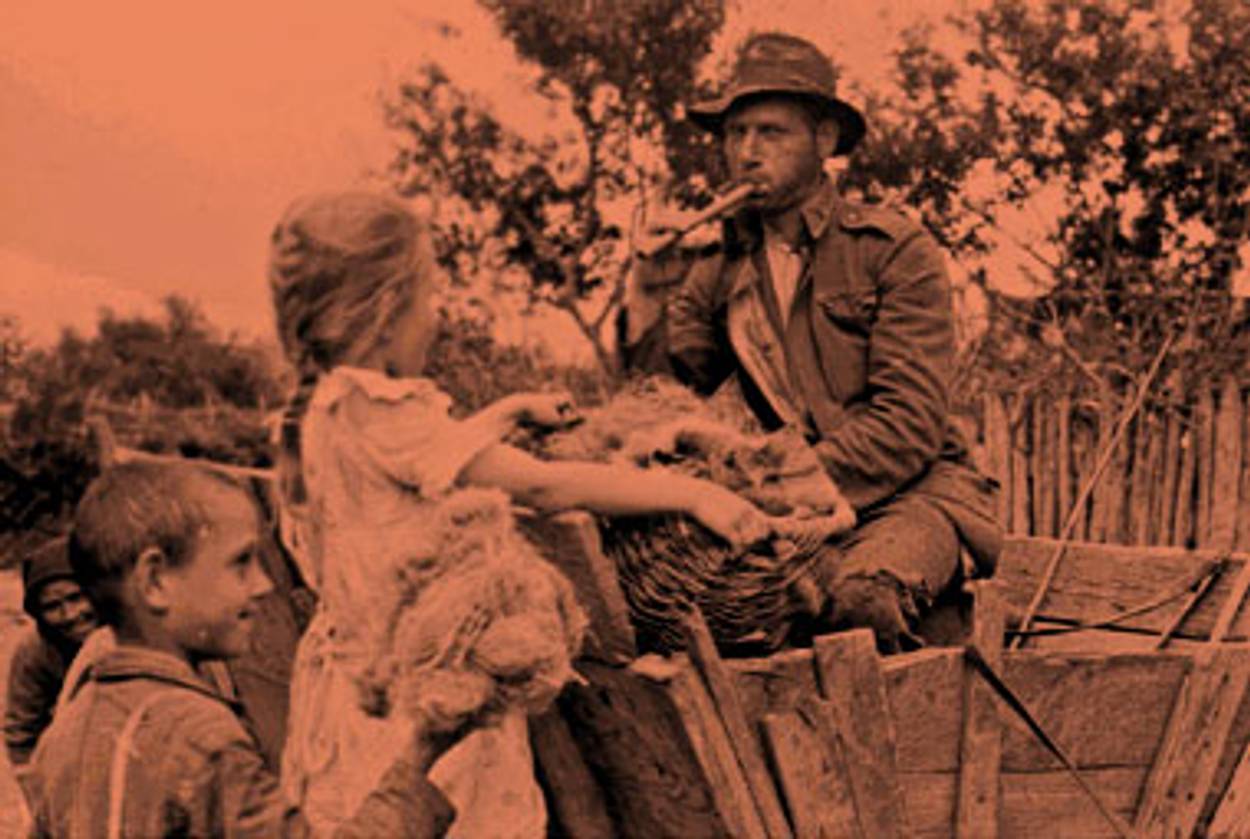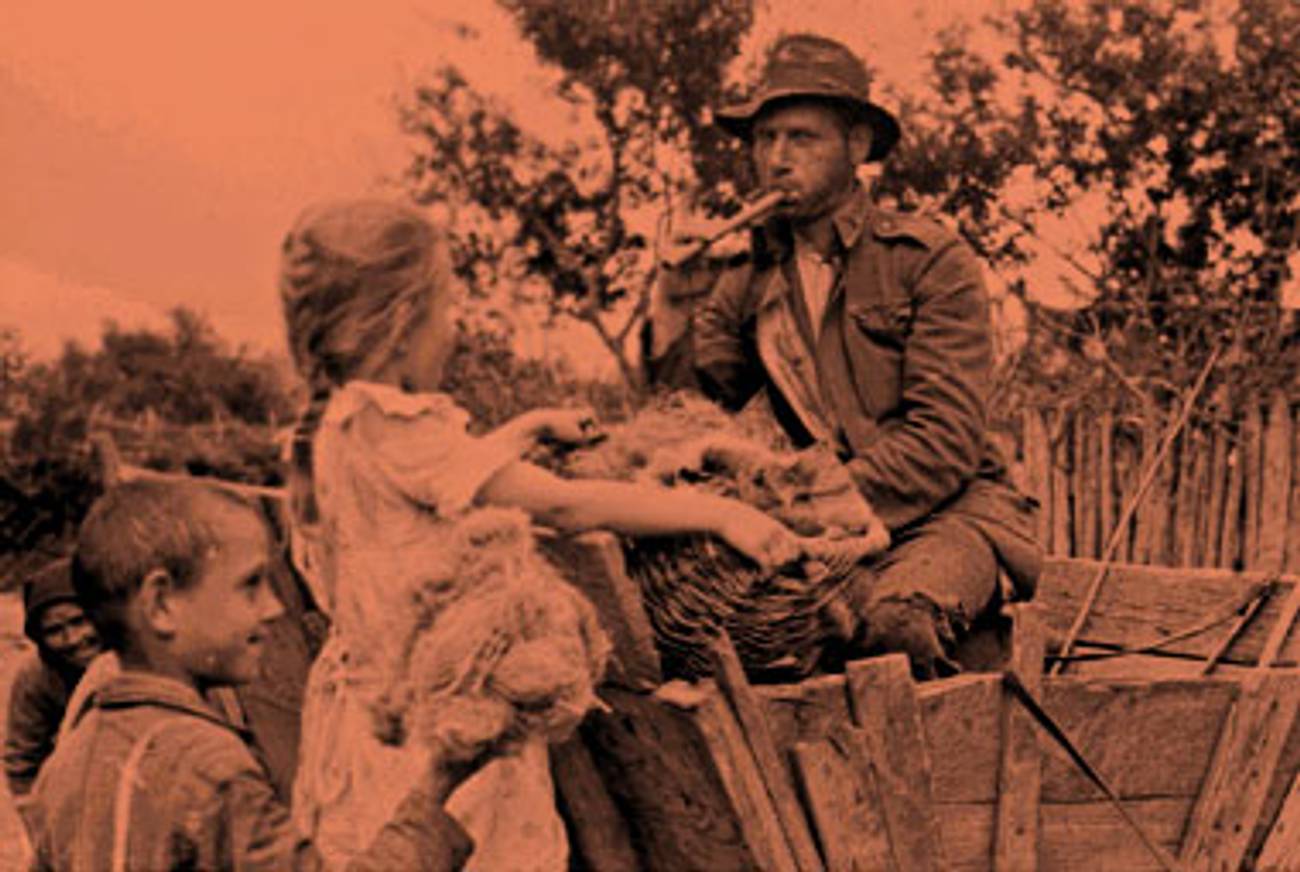Past Imperfect
Two new exhibits explore the fragmentary nature of history




Historical facts are inherently prone to distortion, whether through competing perspectives, unreliable memories, or incomplete documentation. This notion of an inchoate past underpins the work of 59-year-old Hungarian media artist Péter Forgács, best known for haunting films re-orchestrating amateur movies from the Private Photo & Film Archives Foundation he established in 1983. His 2002 “The Danube Exodus: The Rippling Currents of the River,” now on view in New York as part of the yearlong Extremely Hungary arts and culture festival, exposes the prospect of historical manipulation perhaps more brazenly than anything else he has done, dissecting, splicing and augmenting raw footage while also immersing viewers in the unfolding narrative.
This large-scale, interactive installation, at the Jewish Museum through August 2, draws on Forgács’s 1998 film “The Danube Exodus,” which he adapted from Captain Nándor Andrásovits’s documentation of twin voyages made in 1939 and 1940, the former transporting Eastern European Jews fleeing Nazi persecution for Palestine, and the latter evacuating German farmers in the opposite direction, from their adopted homeland of Bessarabia following Soviet annexation. Made in collaboration with the California-based art collective The Labyrinth Project, this ambitious work envelops visitors in a darkened room with five imposing screens and a central touch-computer that invites them to select from 18 segments in the interwoven accounts of the Jewish and Bessarabian journeys, along with treatments on Captain Andrásovits and the river itself. Their complex presentation and potential variations make it impossible to take it all in. Instructions and introductory wall text lay the foundation, but some attendees never even realize that input is required or stay long enough to make sense of what they see, though that is largely the point.
Despite the element of choice, the artist’s hand is evident in carefully edited images, veering from history to ethnography to travelogue. We see life on board for the Jewish passengers, sunbathing, dancing, praying, and even conducting a traditional wedding, but also rationing food and water and sleeping in cramped quarters. We glimpse the Bessarabian voyage, framed by pastiches of a provincial prewar life rooted in agriculture and religion and their subsequent displacement. Rounding these out are scenic shots of the landscape and turbulent sea, highlights of the captain’s nautical career, and contemporaneous footage of Nazism sweeping through the Third Reich. Superimposed upon this visual tapestry are 18th-century drawings of the Danube region, voiceovers of diary entries, and a mesmerizing audio track by Tibor Szemzö, encompassing ambient sounds of the river, mechanical engine noises, the refugees’ folksongs and prayers, classical and jazz music, and his own minimalist compositions.
The dizzying array of images are flipped, morphed, shown up close and from a distance, splashed across the screen or set to linger on time delay. In concert with this nonlinear mode of storytelling, a Bessarabian image often pops up on the far right screen in the middle of a Jewish segment, while the reverse happens on the far left. It is as if these distinct but overlapping dramas are vying for control of the space and, in turn, our attention.
The conflation of these ethnic experiences and suggestion that both groups were swept up in the same maelstrom—what Forgács calls “the incomparable duet of the German-Jewish exodus”—may put some people off, but the exhibition doesn’t deny history, greeting visitors with a timeline and terminals offering eyewitness and news accounts. (Ironically, though their fate was more precarious, the Jews appear more gleeful, perhaps because their destination was the Promised Land.) Rather, Forgács’s concern is the idea of history-writing itself, highlighting the ways in which selections, juxtapositions, and omissions make up our memory.
The Danube Exodus – The Rippling Currents of the River – Installation by Peter Forgacs – Part One from Peter Forgacs on Vimeo.
This sensibility informs even his more traditionally structured work, like “Hunky Blues: The American Dream,” a documentary on Hungarian immigration from 1890-1921 that premiered at MoMA in May and will be screened at the Yale Center for British Art on June 24. Commissioned by the Hungarian Cultural Center for Extremely Hungary, it displays Forgács’s trademark artistry, weaving together clips from early American cinema, found footage, photos, interviews, music and text. So too, at the 53rd Venice Biennale, through November 22, where Forgács is representing Hungary, data of racial profiling from the archive of a Nazi-era anthropologist are taken out of their crudely scientific context—presented in multiple sizes, formats and speeds, and accompanied by cast masks—to make more sweeping points about “looking as a means of power” and present-day xenophobia. As László Jakab Orsós, director of the Hungarian Cultural Center, puts it, Forgács’s work reminds us that “as much as history informs us, we inform history too.”
A more straightforward historical exhibition, also part of Extremely Hungary, is on view at Manhattan’s 92nd Street Y through July 2, but here as well, documentary material is pieced together to share a distinct point of view. “How They Lived: The Daily Lives of Hungarian Jews in Photographs, 1867-1940,” offers highlights of a forthcoming, 300-image publication by Vince Books that illustrates the rich diversity of Hungary’s prewar Jewish community and the vital role it played in the country’s modernization. This is the first comprehensive treatment of the subject, according to curator/author András Koerner, whose 2004 A Taste of the Past: The Daily Life and Cooking of a Nineteenth-century Hungarian-Jewish Homemaker took on a more microscopic focus. Culling through more than 50 sources over three years, his goal here was to present a panorama overlooked in Holocaust literature.
Explaining this void, Koerner points to the scant surviving material and also notes that Russian photographer Roman Vishniac was the only person to systemically capture Hungary’s Jews, mostly in remote regions, while preeminent Hungarian photographers André Kertész, Martin Munkácsi, and Robert Capa were assimilated Jews who avoided ethnic subjects. Moreover, he argues, Hungary’s Jewish population was more complex than in Russia or Poland, where Orthodoxy was dominant, or Western Europe, where most were assimilated, making it difficult to construct a neat picture.
Broken down into anthropological categories—What They Looked Like, Where They Lived, Where They Worked—the photos and accompanying wall text bring to life a thriving, well-integrated population, at least until Hungary’s defeat in World War I. This cataclysm brought about the loss of two-thirds of the country’s territory, economic hardship, and, in 1920, state-sanctioned anti-Semitism. But until that point, Jews were a pivotal force in the transformation from feudal to modern life, leasing rights from Christian middle-class citizens who enthusiastically delegated management responsibilities, and delighting the Hapsburgs, who bestowed noble titles on almost 350 Jewish families. The dynamism of Hungary’s Jewish population is evident in these captivating photos and telling anecdotes: Jews founded Hungary’s first commercial bank in 1841, were disproportionately represented in all commercial enterprises, and embraced avant-garde art forms like film and cabaret.
Koerner may have made a conscious decision to end his presentation before the Holocaust, but he does not ignore it. A pamphlet accompanying the show notes that, “From no other country were so many people deported and murdered in such a short time”—approximately 450,000 in less than one year—and that Jewish life outside Budapest has virtually vanished. More poignantly, an epilogue is dedicated to Koerner’s uncle who was murdered at Auschwitz and includes a personal note of mourning for “the brutal destruction of Hungarian Jewry.”
While Koerner concedes that Forgács’s installation at the Jewish Museum “is more poetic,” glancing towards the images hanging at the Y, he suggested that “in a way, the dry facts have their own poetry.” Beyond this, Forgács’s dynamic artwork and Koerner’s lovingly-performed research share a critical view of history as being shaped by fragmentary information and a broader approach to the Jewish experience that sees it as inextricably linked to larger forces. As Koerner insists, “It is understandable that Jews considered the Holocaust their tragedy but it is not theirs alone. Hungary lost an integral part of its nation.”
Jeannie Rosenfeld is Tablet Magazine’s art critic. Her writing has appeared in ARTnews, Interior Design, and the Forward.
Jeannie Rosenfeld, a Tablet Magazine contributing editor, writes about fine and decorative art.
Jeannie Rosenfeld, a Tablet Magazine contributing editor, writes about fine and decorative art.